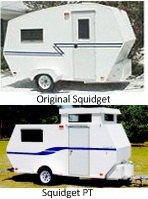My wiring plans
There has been LOTS of discussion on this matter, and LOTS of disagreement. I have my battery grounded to the chassis, and did have my 120 V grounded to the chassis as well, but removed that ground after some thought that it was a bad idea. My converter is grounded to the battery ground, thus to the chassis. Does this mean that my 120 V is grounded to the chassis as well? I just don't know. All I know is that everything works fine. None of my 12 V lights, fan, etc. rely on the chassis ground. All have ground wiring running back to the converter's ground wire. The running lights are grounded back through the wiring and connector to the tow vehicle's ground.
Dale
Sometimes I pretend to be normal. But, that gets boring...so I go back to being me.
Squidget Pop Top Build Pages http://www.thesquidget.com/ptbuild/ptbuild.html
Squidget and Pop Top Plans Info and Photos: http://www.TheSquidget.com
Sometimes I pretend to be normal. But, that gets boring...so I go back to being me.
Squidget Pop Top Build Pages http://www.thesquidget.com/ptbuild/ptbuild.html
Squidget and Pop Top Plans Info and Photos: http://www.TheSquidget.com
-

cracker39 - 3000 Club

- Posts: 3069
- Images: 233
- Joined: Thu Jun 30, 2005 2:18 pm
- Location: Lake Alfred, Florida, USA
Dale's post got me to thinking I may have accidently done something very right.
With the negative leg returning 12 volts to the frame, would this have any effect to a/c gfi's grounded to the same frame ?
Everyone was so against mixing 12 volt and 120 I tried to keep them totally seperate and independent.
I even seperated my inside 12 volt courtesy lights and recepticals from my running light by providing seperate grounds ( negative return legs).
The ac circuits all return to a grounding bar and the ground bar is hard wired to the shore ground only.
My running light return hard wired all the way back to the tow vehicles ground.
The on board 12v courtesy circuits return to a different grounding bar and from there directly wired to the on board battery negative post.
DID I DO GOOD ? They all work properly and one catastrophic failure will be limited to only 1/3 of my circuits.
With the negative leg returning 12 volts to the frame, would this have any effect to a/c gfi's grounded to the same frame ?
Everyone was so against mixing 12 volt and 120 I tried to keep them totally seperate and independent.
I even seperated my inside 12 volt courtesy lights and recepticals from my running light by providing seperate grounds ( negative return legs).
The ac circuits all return to a grounding bar and the ground bar is hard wired to the shore ground only.
My running light return hard wired all the way back to the tow vehicles ground.
The on board 12v courtesy circuits return to a different grounding bar and from there directly wired to the on board battery negative post.
DID I DO GOOD ? They all work properly and one catastrophic failure will be limited to only 1/3 of my circuits.
Growing older but not up !
-

bobhenry - Ten Grand Club

- Posts: 10359
- Images: 2623
- Joined: Fri Feb 09, 2007 7:49 am
- Location: INDIANA, LINDEN



